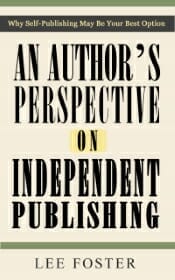By Lee Foster
 Book publishing best practices are evolving quickly around us. For each of us, the challenge is: How clearly are we seeing the big trends? And then: Are we making the practical adjustments to position ourselves successfully?
Book publishing best practices are evolving quickly around us. For each of us, the challenge is: How clearly are we seeing the big trends? And then: Are we making the practical adjustments to position ourselves successfully?
I’ve been thinking about these issues as I work on the 2019 update of my book on publishing, An Author’s Perspective on Independent Publishing: Why Self-Publishing May Be Your Best Option.
The book chapters are a manageable 10 aspects of modern book publishing. Here is a main trend and some key practical adjustments to keep in mind for each chapter.
1. How Traditional Publishing Worked (and Sometimes Still Works)
The shocking news today is the continuing deterioration of many of the landmark traditional publishers of books, magazines, and newspapers.
One of those in decline here in California is Sunset Publishing, which was the gold standard for dependable book contracts. I did a work-for-hire how-to book for Sunset long ago, and all went well, so I am not affected now. But a colleague today is owed $5,000 and is unsure of his prospects. Sunset’s utter collapse is public knowledge and would shock the founders, Mel and Bill Lane.
The practical reaction is to review your relationships, if you have any, with traditional publishers and see how things are going. Keep your relationships positive and see what is advantageous to you. For example, I had a successful travel book Northern California History Weekends with publisher Globe Pequot.
We worked well together and the book sold for 15 years. When they said last year that they would soon print a new 1,000 copies, I asked if they would just return all publishing rights to me. They said, “OK.” Soon I will have updated all the chapters and come out with a new self-published edition, as a print book, ebook, and website book.
If you have done any books with traditional publishers, what rights back might you secure, if you ask?
2. Why Independent Publishing─Also Known as Self-Publishing─Arose
One aspect of good news in modern publishing is that self-publishing continues to evolve as a practical path to success.
As Amazon appears to sell maybe 60% of all print books and maybe 80% of all ebooks (please correct my data if you know better), the independent publisher gets an ever-more-level playing field in the search for an audience. Moreover, Ingram, which can service all bookstores with printed books, continues to evolve as a welcoming home for the self-publisher.
One practical reaction to consider is to look around in your region and try to find a self-publishing group that supports your dreams. Collectively, we can learn a lot from colleagues as we strive for better covers, more inviting interior layouts, and more adroit editing.
The national organization IBPA lists regional affiliates, maybe one in your area. In the San Francisco region, I benefit from the monthly meeting of BAIPA. Joel Friedlander has been a leader in this local org.
Many examples of inspiring self-pub success can be seen at our monthly meetings. For example, I’ve watched for a couple of years as Steven Kessler, a psychology self-help author, reports on his progress. There are a hundred aspects of his story, some of which apply to me and to you. Steven announced last month that he had sold 10,000 copies of his book. Good things can happen.
3. Why Independent Publishing May Be Your Most Viable Option Now and in the Future
The “control factor” in indie publishing becomes more appealing to me every year as I think back on my “traditional publishing” ventures and our changing times.
For example, the Globe Pequot people who did my Northern California History Weekends (mentioned above) wanted a print book only. They had no interest in an ebook. As the ebook era arose, I gently encouraged them to pursue this new form. They said no. There was nothing I could do. The entire content was locked up in a print book and could not be exploited in any other way.
But now, with the book content back under my control, I can create not only the print book, but also an ebook. I can, and am, developing the 52 chapters in the book as website articles, making this a “website book.”
Think about your book dreams. What is the max that you could achieve in terms of forms?
- Print book?
- Plus ebook?
- Possibly also a “website book”?
- What about an audiobook of your book?
- What about licensing of your content?
- What about translation of your book into Chinese, the most widely read and spoken language on our planet?
Control over your destiny is a positive, the first step to success.
4. Your Print-on-Demand Book
Advancing print-on-demand technology (POD) has changed everything, and has spurred on the self-publishing movement. Color interiors at an affordable price could be the next breakthrough.
Because of print on demand, I don’t need huge capital to develop my books, as long as I stay with black-and-white only. Because of capital requirements for offset printing, we formerly needed traditional publishers.
The economics of self-publishing are favorable.
- I earn about $1 royalty per book sold on my traditionally-published $14.95 book with Countryman/Norton titled The Photographer’s Guide to San Francisco.
- I earn about $4 per book sold for my self-published $14.95 book Northern California Travel: The Best Options.
With print-on-demand, I don’t have to ship. My partners, Amazon and Ingram, take care of that.
The practical task at hand is to keep track of the evolving details in the two major print-on-demand worlds:
- Amazon Kindle Direct (no longer CreateSpace)
- Ingram Spark
Joel Friedlander has a new step-by-step product on the details of the new Kindle Direct scene.
One vulnerability for authors is that the print-on-demand supplier can raise its per-page cost, as Ingram did recently. You might need to change your book price to keep it reasonably profitable.
Keep track of where the players continue to expand their global POD manufacturing network. Amazon and Ingram can now POD print in England and Australia.
It’s thrilling to know that foreigners can get your book tomorrow in those distant locations. Someone can order your POD book in London and get it tomorrow. No expensive overseas shipping is needed.
Self-publishing authors benefit immensely as this revolution proceeds.
5. Your Ebook Distribution
It is always helpful to remind ourselves of roughly the distribution of sales for what we ordinarily call “books.”
It appears to be about:
- 70% print
- 17% ebooks
- 6% audiobooks
Rather than debate what format your book should be, just give the consumer every format that is appropriate for your book.
Start with the print book and the ebook. Possibly you have experienced, as I have, satisfied ebook consumers with poor eyesight who say, “Thank goodness for ebooks. I can make the type size as big as I want.”
Managing the best plan for ebooks for yourself is an ongoing challenge. I generally recommend now that you go with Amazon Kindle directly for Amazon and then with Smashwords for everyone else.
Keep the layout simple and “flowing” so the consumer can increase the type size and change the font, as they might wish, even on their phone readers.
One big issue with Amazon is whether you will go with them exclusively or not. Exclusivity is required to allow you to benefit from their KENP (Kindle Edition Normalized Pages) income for subscription reads. I don’t like exclusivity for myself, but your best path may differ. I’ve seen many exclusivity requirements ultimately damage the content creator in the stock photo marketing world, for example.
In conclusion, please share with us your success or disappointment as you observe the book publishing scene evolve quickly.
What’s happening with you, for better and for worse, as you struggle to keep up?
Watch for Part 2 of this discussion in about five weeks.
Photo: BigStockPhoto. Amazon links contain affiliate code.


